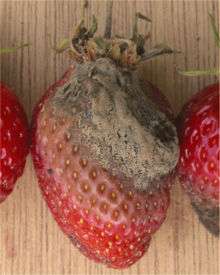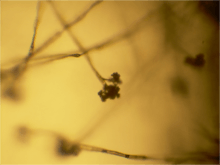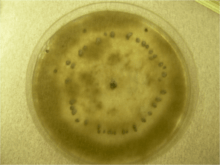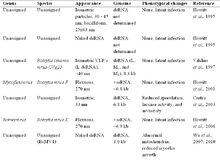Botrytis cinerea
| Botrytis cinerea | |
|---|---|
 | |
| Botrytis cinerea infection on strawberry | |
| Scientific classification | |
| Kingdom: | Fungi |
| Division: | Ascomycota |
| Class: | Leotiomycetes |
| Order: | Helotiales |
| Family: | Sclerotiniaceae |
| Genus: | Botrytis |
| Species: | B. cinerea |
| Binomial name | |
| Botrytis cinerea Pers. (1794) | |
Botrytis cinerea ("botrytis" from Ancient Greek botrys (βότρυς) meaning "grapes"[1] plus the Neolatin suffix -itis for disease) is a necrotrophic fungus that affects many plant species, although its most notable hosts may be wine grapes. In viticulture, it is commonly known as botrytis bunch rot; in horticulture, it is usually called grey mould or gray mold.
The fungus gives rise to two different kinds of infections on grapes. The first, grey rot, is the result of consistently wet or humid conditions, and typically results in the loss of the affected bunches. The second, noble rot, occurs when drier conditions follow wetter, and can result in distinctive sweet dessert wines, such as Sauternes or the Aszú of Tokaji/Grasă de Cotnari. The species name Botrytis cinerea is derived from the Latin for "grapes like ashes"; although poetic, the "grapes" refers to the bunching of the fungal spores on their conidiophores, and "ashes" just refers to the greyish colour of the spores en masse. The fungus is usually referred to by its anamorph (asexual form) name, because the sexual phase is rarely observed. The teleomorph (sexual form) is an ascomycete, Botryotinia fuckeliana, also known as Botryotinia cinerea (see taxonomy box).
Biology


Botrytis cinerea is characterized by abundant hyaline conida (asexual spores) borne on grey, branching tree-like conidiophores. The fungus also produces highly resistant sclerotia as survival structures in older cultures. It overwinters as sclerotia or intact mycelia, both of which germinate in spring to produce conidiophores. The conidia, dispersed by wind and by rain-water, cause new infections.
Different Botrytis cinerea strains show considerable genetic variability (polyploidy).
Gliocladium roseum is a fungal parasite of Botrytis cinerea.[2]
Viticulture
In the Botrytis infection known as "noble rot" (pourriture noble in French, or Edelfäule in German), the fungus removes water from the grapes, leaving behind a higher percent of solids, such as sugars, fruit acids and minerals. This results in a more intense, concentrated final product. The wine is often said to have an aroma of honeysuckle and a bitter finish on the palate.
A distinct fermentation process initially caused by nature, the combination of geology, climate and specific weather led to the particular balance of beneficial fungus while leaving enough of the grape intact for harvesting. The Chateau d'Yquem is the only Premier Cru Supérieur, largely due to the vineyard's susceptibility to noble rot.
Botrytis complicates winemaking by making fermentation more complex. Botrytis produces an anti-fungal that kills yeast and often results in fermentation stopping before the wine has accumulated sufficient levels of alcohol. Makers of fine German dessert wines have been known to take fermenting tubs of wine into their homes to nurture the yeast through the night to assure that the alcohol level reaches legal minimums for the product to be called wine.

Botrytis bunch rot is another condition of grapes caused by Botrytis cinerea that causes great losses for the wine industry. It is always present on the fruitset, however, it requires a wound to start a bunch rot infection. Wounds can come from insects, wind, accidental damage, etc. To control botrytis bunch rot there are a number of fungicides available on the market. Generally, these should be applied at bloom, bunch closure and veraison (the most important being the bloom application). Some winemakers are known to use the German method of fermentation and prefer having a 5% bunch rot rate in their grapes and will usually hold the grapes on the vine a week longer than normal.
Horticulture
Botrytis cinerea affects many other plants. It is economically important on soft fruits such as strawberries and bulb crops.[3] Unlike wine grapes, the affected strawberries are not edible and are discarded. To minimize infection in strawberry fields, good ventilation around the berries is important to prevent moisture being trapped among leaves and berries. A number of bacteria have been proven to act as natural antagonists to B. cinerea in controlled studies.[3]
In greenhouse horticulture, Botrytis cinerea is well known as a cause of considerable damage in tomatoes.
The infection also affects rhubarb, snowdrops, white meadowfoam, and cannabis. Potassium bicarbonate-based fungicide has been proven to cure and prevent powdery mildew, blackspot, downy mildew, blights, molds and other plant diseases, such as Botrytis cinerea.
Human disease
Botrytis cinerea mold on grapes may cause "winegrower's lung", a rare form of hypersensitivity pneumonitis (a respiratory allergic reaction in predisposed individuals).
Mycoviruses of Botrytis cinerea
Botrytis cinerea not only infects plants, it also hosts several mycoviruses itself (see Table).

A range of phenotypic alterations due to the mycoviral infection have been observed from symptomless to mild impact, or more severe phenotypic changes including reduction in growth/suppression of mycelia, sporulation and sclerotia production, formation of abnormal colony sectors (Wu et al., 2010[4]) and virulence.
Hosts
See:
- List of potato diseases
- List of canola diseases
- List of maize diseases
- List of alfalfa diseases
- List of African daisy diseases
- List of African violet diseases
- List of pea diseases
- List of lentil diseases
- List of anemone diseases
- List of almond diseases
- List of apple diseases
- List of apricot diseases
- List of asparagus diseases
- List of avocado diseases
- List of azalea diseases
- List of beet diseases
- List of bellflower diseases
- List of bleeding heart diseases
- List of butterfly flower diseases
- List of caneberries diseases
- List of carrot diseases
- List of tea diseases
- List of tobacco diseases
- List of tomato diseases
- List of verbena diseases
- List of sweet potato diseases
- List of sunflower diseases
- List of strawberry diseases
- List of sapphire flower diseases
- List of safflower diseases
- List of rose diseases
- List of primula diseases
- List of poinsettia diseases
- List of pocketbook plant diseases
- List of pistachio diseases
- List of pigeonpea diseases
- List of Persian violet diseases
- List of Capsicum diseases
- List of pear diseases
- List of peanut diseases
- List of peach and nectarine diseases
- List of mimulus, monkey-flower diseases
- List of mango diseases
- List of lettuce diseases
- List of kalanchoe diseases
- List of Jerusalem cherry diseases
- List of impatiens diseases
- List of hop diseases
- List of hemp diseases
- List of grape diseases
- List of geranium diseases
- List of fuchsia diseases
- List of cyclamen diseases
- List of cucurbit diseases
- List of crucifer diseases
- List of citrus diseases
- List of cineraria diseases
- List of chickpea diseases
- List of cattleya diseases
- List of carnation diseases
- List of Douglas-fir diseases
- List of dahlia diseases
- List of foliage plant diseases (Araceae)
- List of foliage plant diseases (Acanthaceae)
- List of foliage plant diseases (Agavaceae)
- List of foliage plant diseases (Araliaceae)
- List of foliage plant diseases (Asclepiadaceae)
- List of foliage plant diseases (Gesneriaceae)
- List of Ficus diseases
- List of foliage plant diseases (Polypodiaceae)
- List of foliage plant diseases (Vitaceae)
- List of rhododendron diseases
References
- ↑ βότρυς. Liddell, Henry George; Scott, Robert; A Greek–English Lexicon at the Perseus Project
- ↑ Yu H, Sutton JC (1997). "Morphological development and interactions of Gliocladium roseum and Botrytis cinerea in raspberry" (PDF). Canadian Journal of Plant Pathology. 19 (3): 237–246. doi:10.1080/07060669709500518.
- 1 2 Donmez, M. F.; Esitken, A.; Yildiz, H.; Ercisli, S. Biocontrol of Botrytis Cinerea on Strawberry Fruit by Plant Growth Promoting Bacteria, The Journal of Animal & Plant Sciences , 21(4), 2011: pp. 758-763, ISSN 1018-7081.
- ↑ Wu M. D.; Zhang L.; Li G.; Jiang D.; Ghabrial S. A. (2010). "Genome characterization of a debilitation-associated mitovirus infecting the phytopathogenic fungus Botrytis cinerea". Virology. 406 (1): 117–126. doi:10.1016/j.virol.2010.07.010. PMID 20674953.
External links
| Wikimedia Commons has media related to Botrytis cinerea. |
- Genome information for Botrytis cinerea
- Genome analysis of Botrytis cinerea
- Choquer M, Fournier E, Kunz C, et al. (December 2007). "Botrytis cinerea virulence factors: new insights into a necrotrophic and polyphageous pathogen". FEMS Microbiol. Lett. 277 (1): 1–10. doi:10.1111/j.1574-6968.2007.00930.x. PMID 17986079.
- TheWineDoctor.com
- Büttner P, Koch F, Voigt K, et al. (May 1994). "Variations in ploidy among isolates of Botrytis cinerea: implications for genetic and molecular analyses". Curr. Genet. 25 (5): 445–50. doi:10.1007/BF00351784. PMID 8082191.
- Vallejo, I.; Santos, M.; Cantoral, J. M.; Collado, I. G.; Rebordinos, L. (2004). "Chromosomal polymorphism in Botvytis cinerea strains". Hereditas. 124: 31. doi:10.1111/j.1601-5223.1996.00031.x.
- Staats M, van Baarlen P, van Kan JA (February 2005). "Molecular phylogeny of the plant pathogenic genus Botrytis and the evolution of host specificity". Mol. Biol. Evol. 22 (2): 333–46. doi:10.1093/molbev/msi020. PMID 15496556.